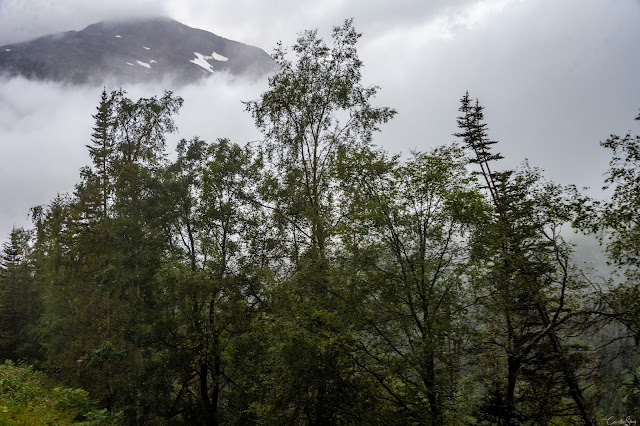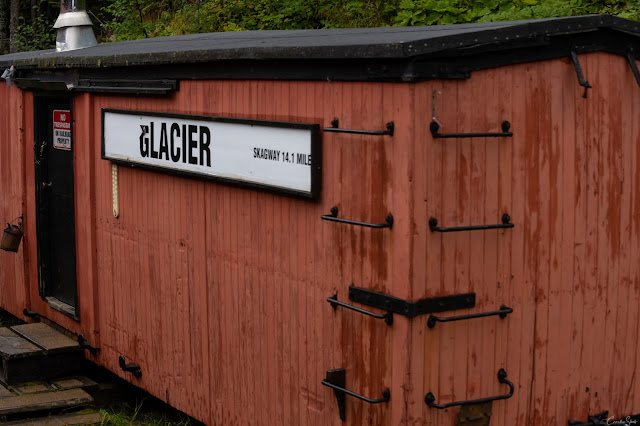Have you ever read the book by Jack London called The Call of The Wild?
If you have, then you know that the inpsiration for the storyline came from Jack London's visit to the Klondikes. In reality several of his most famous books were created based on his eleven month experience in the Klondikes.
While Jack London's motivation to travel to the Yukons was gold, which he never found, today's travels to the area are motivated by the scenic landscape.
One of the most popular land-based excursion in Alaska is the White Pass & Yukon Route train, and yours truly signed up for it.
" Skagway and Dyea are two important entry points into the interior of Canada because of their location at the end of the Inside Passage. When the first gold prospectors arrived at the end of the Lynn Canal in 1897 they had to make a decision. They could choose the 45 mile White Pass Trail out of Skagway or the 33 mile Chilkoot Trail out of Dyea. The two trails end at the shores of Lake Bennett in the Yukon Territory at the headwaters of the Yukon River. Both trails are ice free and low in elevation making them the most practical way to cross over the Coastal Mountains into the interior of Canada. The White Pass Trail lacked the steep slopes of the Chilkoot, but it was 10 miles longer and had its own obstacles. The trail became clogged with mud during the wet fall months of 1897, making it impassable at some spots."
" As the fall of 1897 turned into the winter of 1898 stampeders continued to pour through Skagway and up the trail. With only a few short summer months when the lakes and rivers were not frozen it became almost impossible to bring goods to the Yukon. One man, Micheal James Heney, believed that there was a better way of getting goods over the pass rather than taking the wagon road. After witnessing $800,000 (24 million in 2018) of Klondike gold in Seattle on July 17th, 1897, Heney bought a ticket to Alaska. Heney was a Canadian railway contractor. His early fascination of railroads, building, and design didn’t shy him away from the challenge of dreaming up a railroad that went over the mountain pass.
A chance encounter at the St. James Hotel in Skagway led Heney to meet Erastus C. Hawkins from Seattle and British Engineer Sir Thomas Tancrede. These two men were representing a group of British financiers, the Close Brothers, who wanted to finance the endeavor."
"The railroad began construction in 1898 during the Klondike Gold Rush as a means of reaching the goldfields. With its completion in 1900, it became the primary route to the interior of the Yukon, supplanting the Chilkoot Trail and other routes. The route continued operation until 1982, and in 1988 was partially revived as a heritage railway. In July 2018, the railway was purchased by Carnival Corporation & plc."
"In 1982, metal prices plunged, striking with devastating effect on the mines that were the White Pass and Yukon Route's main customers. Many, including the Faro lead-zinc mine, closed down, and, with that traffic gone, the White Pass was doomed as a commercial railroad. Hopeful of a reopening, the railway ran at a significant loss for several months, carrying only passengers. However, the railway closed down on October 7, 1982.
The shutdown, however, was not for long. Tourism to Alaska began to increase, with many cruise ships stopping at Skagway. The scenery of the White Pass route sounded like a great tourist draw; and the rails of the White Pass & Yukon Route were laid right down to the docks, even along them, for the former freight and cruise ship traffic. Cruise operators, remembering the attraction of the little mountain climbing trains to their passengers, pushed for a re-opening of the line as a heritage railway."
"The railway still uses vintage parlor cars, the oldest four built in 1881 and predating WP&YR by 17 years, and four new cars built in 2007 follow the same 19th-century design. Most trains are hauled by the line's diesel locomotives, painted in green (lower) and yellow (upper), but one of the line's steam locomotives is still in operation too."
"Rising 2,865 feet, the summit of the White Pass trail is approximately 20 miles from the shores of Skagway. Conditions at the summit were very harsh for gold seekers passing over the border into Canada. During the summer months millions of mosquitoes use these lakes as breeding grounds. In the winter it could snow up to 200 feet on the pass with wind chills at -80 degrees F. These weather conditions made the summit uninhabitable by most people. The North West Mounted Police (NWMP) stationed at the summit of the White Pass lived in very rough conditions. Expecting trouble from stampeders they came equipped with machine guns. Their job was to collect duties and customs to be paid to the Queen of England. At the time Canada was a colony of the British Empire."

"As the self-proclaimed “Gateway to the Yukon” and “Railway built of gold,” the White Pass and Yukon Route Railroad had been designated an International Historic Civil Engineering Landmark in 1994, one of only 36 world designs, including the Panama Canal, to do so, because of the obstacles surmounted during its construction, and today it is the only international narrow-gauge railroad still operating in North America."
For the 2022 Alaska cruise season, the first train ran on April 26th with the arrival of the first cruise ship. The White Pass train schedules its tours based on the arrival of cruise ships.Employees spend the first two months clearing the tracks of snow before each season. Rockslides are rare, but the tracks are inspected each day before the first train run.

Before the pandemic, the train traveled further, and passengers disembarked for a journey back by bus. However, in 2022, the Yukon was not allowing train travelers due to the lengthy process of providing proof of vaccinations.
So, until further notice, the route is abbreviated. While it crosses into Canada, the train completes a loop before heading back down.
And to finalize our 2.5 hour tour of the most stupendous scenery of mountains, glaciers, gorges, waterfalls, tunnels, trestles and historic sites, a quick portrait of our conductor. 😉
Below is a map of the White Pass and Yukon route-
The following video showcases in-depth the White Pass & Yukon Route Railroad in Skagway, Alaska.






















































































Fantastic, I have to go to Dead Horse Gulch just for the name. Incredible trip and scenery. I remember my Geography teacher telling us in the mid 70's that then the daily income for Alaska for gold output was equal to what the US purchased Alaska for. This was before the oil started and after gold mining was virtually finished. Someone got the bargain of the millennium.
ReplyDeleteHad to look it up because I hadn't learned that piece of info...according to posts I found...2 cents an acre. What a steal!
DeleteGreat tour! I wished we had been able to get Skagway on our itinerary. Beautiful shots and such great scenery. I especially loved the shots of the train as it curled around those long corners and the misty valleys. Thanks for sharing that!
ReplyDeleteThanks John. I too loved the curls and took tons of shots of it, but didn't post them all because.....well you know 😁
Delete